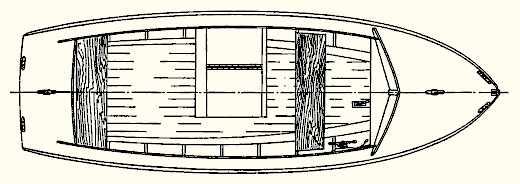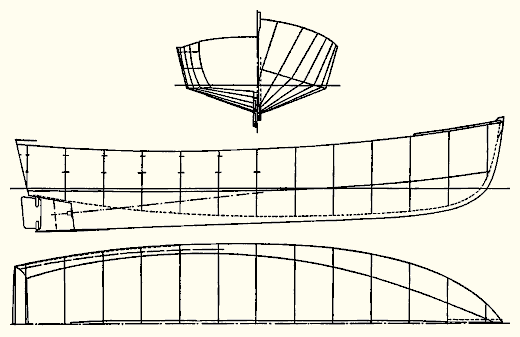
| Ketewomoke A 23' 3" V-Bottom Utility By William & John Atkin |
| A Practical Inboard-Powered Utility | |
| Several hundred years ago the site of the town of Huntington, L. I., N. Y., and its surrounding waters was named by the Indians, Ketewomoke. The Indian name was chosen by the yacht club at Halesite, of which, by the way, I was a charter member. The club was formed in 1913; that is a long time ago. As a token of respect for that friendly organization, the latest member of MoToR BoatingG's family of practical boats bears the name Ketewomoke. | |

| |
| For fishing, for picnic parties, for livery service, for tendering at a yacht club, for work around a yacht yard, and for day sailing the little V-bottom boat shown here will be difficult to improve upon. She has the ability to carry a heavy load without danger of capsizing and without too great a loss of speed. She is reasonably fast, an excellent sea boat, dry in rough water and exceptionally stable. She was designed for use in rough water and is not in any respect an experiment. She is of practical design, an easy boat to build and an easy boat to take care of; the latter is an important feature, and one which can be easily overlooked in the acquirement of a boat. | |

| |
The deck plan shows a short deck both forward and aft and a 6-inch wide deck both sides of the cockpit. The cockpit is 14 feet 10 inches long by 6 feet 5 inches wide. It is not self draining. The motorhouse is about amidship and stands to port as shown; this leaves a two-foot wide passage alongside. There are several advantages in this form of motor house; it provides stowage space for oil tins, forms a dry place for the storage battery, and permits leading the exhaust pipe to the side of the boat, and thence aft to the transom. The pipe will run down hill for its entire length and not clutter up the cockpit floor space. Overall length is 23 feet 3 inches, the waterline length is 22 feet, the breadth is 7 feet 10 inches, and the draft 2 feet 1 1/2 inches. The keel extends nearly the full length of the boat. Unlike most of our designs the rudder is inboard, the heel of which is held and protected by a bronze shoe. The freeboard at the bow is 3 feet 3 inches, the least freeboard is 1 foot 10 inches, and the freeboard at the stern is 2 feet 2 inches. In connection with the freeboard it will be noticed that there is rather more flare in all the topside sections than is usually found in a boat of this kind. The forward end of the chine makes an easy entrance and gives generous depth to the forward sections below the waterline forming non-pounding sections. The breadth of the deck, especially forward of amidships, accounts for the exceptional flare which is gotten without excessive freeboard. All the topside sections from station 0 to station 8 are straight; abaft this point the topside sections are molded, that is, curved as shown. All the bottom sections are straight from the rabbet to the chine corner. | |

| |
| There was a time when nearly all V-bottom boats had concave curves below the chine from bow to stern; in light of later years it is very doubtful how much, if any, speed is gained by this practice. It most certainly makes a more difficult-to-build boat. Ketewomoke was not designed for high speed but rather for comfortable speeds of from 12 to 16 m.p.h. The plans show a 133 cubic inch Scripps four-cylinder motor of 25 to 45 h.p. Universal, Lathrop, Gray, Red Wing, Palmer, and several other manufacturers make marine motors of this size and power, any one of which will suit this design. Greater power than the above will be wasted in this particular hull. While on the subject of the lines it might be pointed out that the long keel has drag and sweeps upward to meet the stem in an easy curve. The result of this will be an easily steered boat and one which will hold a straight course. When running off a rough sea she will not yaw. The latter is a fault found in the performance of some small boats. | |
| Plans for Ketewomoke are $100 MYSTIC SEAPORT MUSEUM SHIPS PLANS STORE https://store.mysticseaport.org/ships-plans/ shipsplanstore@mysticseaport.org
+1 (860) 572 5360 | |
| BACK TO PLAN LIST | |